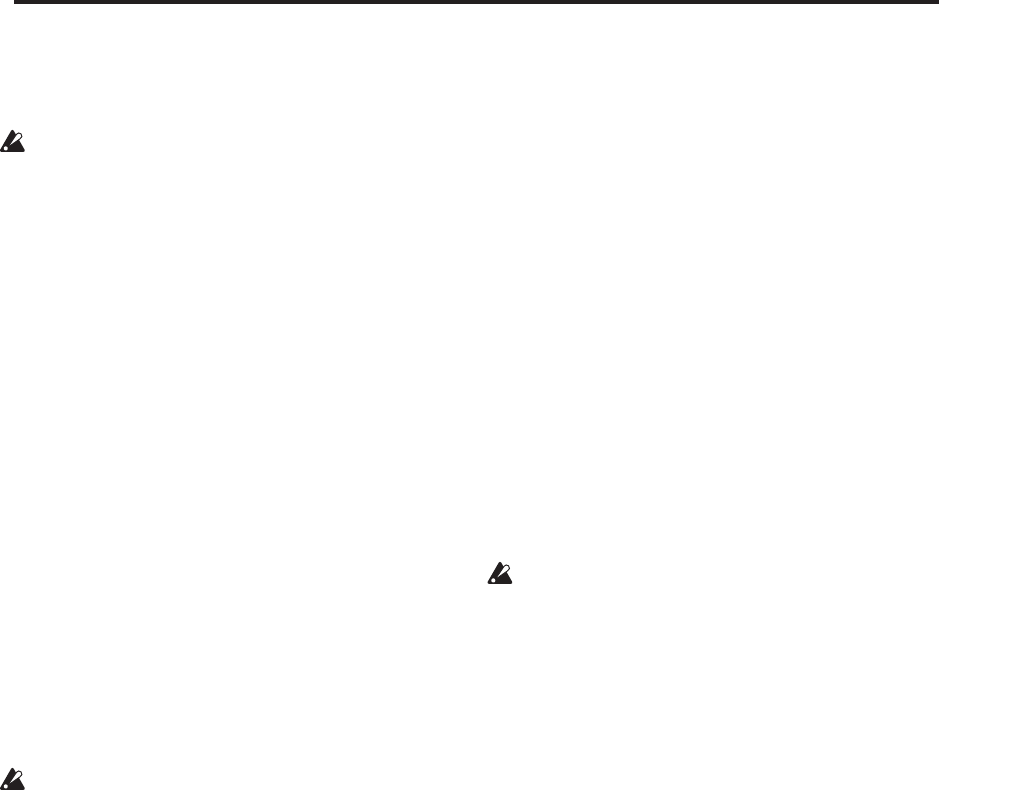
Phase Group General Parameters
905
in the middle of the Note Series from which the
indexes can be chosen in either direction according to
the Index Pattern.
Not available when “GE Type” (☞p.897) = 1:
Generated-Gated. If 2: Generated-Drum, the Note
Series can be applied as pitch bend, discussed
elsewhere.
Length Mode [0…2]
Selects one of several modes for determining when a
Phase Change from the current step to the next step of
the Phase Pattern will occur. Note that this has a
certain interaction with the Cycle Mode parameter,
described below.
0: AC-Actual
Causes the Phase Change to be completely dependent
on the length of the Note Series and the Phase
“Beginning/End Offsets.” The portion of the Note
Series to be used as specified by the Phase
“Beginning/End Offsets” (described below) is referred
to as the “playback portion” of the Note Series. The
notes are generated by moving through the Note series
according to the Index Group settings; when either end
of the playback portion has been reached, a Phase
Change occurs. Therefore, if more or less notes are
played, the Phases will change sooner or later and bear
no relation to any time signatures or specific number of
events. This is useful for GEs that model the behavior
of most simple arpeggiators.
Not available if “GE Type” (☞p.897) = 1:
Generated-Gated.
1: TS-Time Signature
Makes the Time Signature parameters (“Tsig
Numerator/Denominator”
☞p.11) available in the
Phase Specific Parameter area of each Phase (described
below). These allow setting each Phase to various time
signatures, which cause the Phase to playback a certain
number of beats regardless of any other circumstances
that might trigger a Phase Change. When moving
through the Note Series, if either end of the playback
portion is reached (specified by the “Phase
Beginning/End Offsets” ☞p.907) before the amount of
beats specified has occurred, then the movement either
freezes, generates silence, wraps around, or cycles back
and continues (depending on the setting of the “Cycle
Mode” parameter, described below). Useful for groove
generation and constraining effects to certain time
signatures.
2: EV-Events
Makes the “Events” parameter available in the Phase
Specific Parameter area of each Phase (described
below). This is used to set the Phase to perform a
certain number of events before changing Phases (an
event being a note or cluster). When moving through
the Note Series, if either end of the playback portion is
reached (specified by the “Phase Beginning/End
Offsets” ☞p.907) before the number of events specified
has occurred, then the movement either freezes,
generates silence, wraps around, or cycles back and
continues (depending on the setting of the “Cycle
Mode” parameter, described below). Useful for
constraining effects to a certain number of specific
events, such as 4 strums per Phase.
Cycle Mode [0…3]
Determines what will happen when either end of the
playback portion of the Phase (specified by the “Phase
Beginning/End Offsets” (☞p.907) and/or the length of
the Note Series) is reached during note generation. If
the “Length Mode” is 1: TS - Time Signature or 2: EV -
Events, cycling can be allowed to occur. This has a
different effect depending on the setting of the Phase
“Length Mode” (above).
Not available if “Phase Length Mode” (above) = 0:
Actual. Not available if “GE Type”= 1: Generated-
Gated, unless “Gate Type” (☞p.897) = 1:Vel CP. If
“GE Type” = 2: Generated-Drum, the Note Series
can be applied as pitch bend, discussed elsewhere.
0: S-replace with silence
If note generation would extend beyond either end of
the playback portion of the Phase, those notes are
skipped and replaced with silence. Once the specified
number of events (including silent notes) or beats of a
time signature are generated, a Phase Change occurs.
This can be used to simulate the Triton Arpeggiator
setting “Arpeggio Type”: As Played.
1: F-fill with top/bottom note
If note generation would extend beyond either end of
the playback portion of the Phase, those notes are
limited and replaced with the bottom or top note of the
Phase. Once the specified number of events or beats of
a time signature are generated; a Phase Change occurs.
Settings of the Index Pattern or Cluster Pattern which
would cause movement beyond that point have no
effect. This can be used to simulate the Triton
Arpeggiator setting “Arpeggio Type”: As Played (Fill).
2: R-restart at other end of Phase
If note generation would extend beyond either end of
the playback portion of the Phase, those notes are
replaced by notes within the playback portion, as if the
riff restarted at the other end. (For the more technically
oriented, the index is kept within range using modulo
division.) Once the specified number of events or beats
of a time signature are generated, a Phase Change
occurs. This can be used to simulate the Triton
Arpeggiator setting “Arpeggio Type”: Running Up.
3: W-wrap at either end of Phase
If note generation would extend beyond either end of
the playback portion of the Phase, those notes are
replaced by notes within the playback portion, as if the
riff is being “wrapped around” the end point. (For the
more technically oriented, the index is kept within
range by inverting it.) Once the specified number of
events or beats of a time signature are generated, a
0: AC-Actual 1: TS-Time Signature 2: EV-Events
0: S-replace with silence
1: F-fill with top/bottom note
2: R-restart at other end of Phase
3: W-wrap at either end of Phase
4: B-cycle back from beginning of Phase
5: E-cycle back from end of Phase
6: BE-cycle back from beginning & end of Phase


















